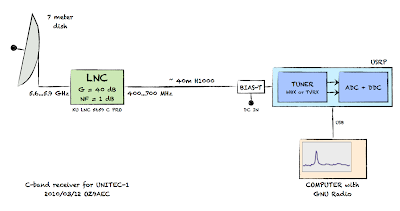Here is a recording of mounting the KU LNC 5659 C PRO downconverter on the 7 meter dish. It took about 20 minutes.
microwaves
C-band Receiver Hardware for UNITEC-1
With only a few days left until the launch of UNITEC-1 (May 17) to Venus, we are getting ready to track it and I am trying to catch up on the documentation part – this time a brief description of the receiver hardware.
Recall the system architecture where the 5.84 GHz RF signal is converted to 640 MHz using the KU LNC 5659 C PRO low noise down converter, and…
This article gives a high level walkthrough of the receiver used to convert the 640 MHz IF to digital baseband, i.e. the blue box called USRP in the above diagram.
Bias-T for the UNITEC-1 Receiver
Today I have been looking at the options for bias tees that we can use for the UNITEC-1 receiver. A bias tee (aka. Bias -T) is a simple device that can inject DC voltage into a coax cable. It is often used to provide supply voltage to devices that are mounted on the antenna without … Read more
UNITEC-1: The KU LNC 5659 C PRO has arrived
Yesterday I have received the C-band down-converter that I have ordered last week for the UNITEC-1 receiver station. Watch video on YouTube. I have also uploaded a few high resolution photos to my Picasa Albums: If you can’t read the specs, you can see them on my work-in-progress wiki page about the C-band Receiver Station. … Read more
UNITEC-1: A New Deep Space Adventure
If everything goes according to current plans, JAXA will launch their PLANET-C spacecraft towards Venus on May 18, 2010. To fill out the empty space and available payload mass on the H-IIA rocket, they will also bring four university built cubesats into orbit. One of these cubesats, UNITEC-1, is very special in that it will … Read more
WBX Transceiver Tests using GNU Radio and USRP
This video shows my first on-the-air tests with the WBX transceiver using the USRP (Universal Software Radio Peripheral) and GNU Radio.
The receiver was tested using wide band FM broadcast, APT signal from NOAA 17 satellite and Copenhagen VOLMET. I have also performed some tests using DVB-T signal and wireless sensor signals but I wanted to keep the video short so these were not included. I can post them in separate videos if there is interest.
Portable S-band Ground Station Update
I made good progress with the portable S-band ground station this week.

I took the receiver to the OZ7SAT lab to measure its performance. Using the USRP+DBSRX and no LNA we could easily detect a -132 dBm CW signal with modest FFT integration (fraction of a second) in a GNU Radio spectrum scope. Using the LNA we could go down to about -138 dBm, i.e. an improvement in SNR of 6 dB. These figures were measured at an SNR ~5 dB. This is excellent, but please note that this is not real “sensitivity” in the traditional sense because we were not demodulating or decoding the signal. We were simply integrating the spectrum for a fraction of a second to detect the presence of the signal. The measurements were done by sampling a 250 kHz wide spectrum.
New vLog: Introducing the S-band Ground Station Project for LRO/LCROSS Reception
In this new video blog I am introducing a new project that has kept me occupied for a few weeks now: A low cost S-band ground station for receiving signals from NASA’s lunar spacecrafts LRO and LCROSS. More info at Receiving LRO and LCROSS. Based on the Universal Software Radio Peripheral (USRP) with DBSRX daughterboard, … Read more
